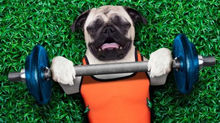GET A GRIP - How should you be holding Barbells?
- Noah Ray Sundell
- Dec 5, 2017
- 3 min read
Most of the time, I find that how folks grip dumbbells and barbells comes down to the classic gym book of “monkey see, monkey do”. To be clear, I don’t think this is inherently a bad thing. Best case scenario, you’ll engage new muscles; but worst case, you’re not protecting a joint as much as you could be. Most of the time, in generally healthy gym go-ers, you can’t do too much damage with a new grip. Let’s look at which one(s) you can add to your arsenal.
In general.
The further your hands are from the center of your body, the more difficult a movement will be. This reins true for exercises like Lat Pulldowns and Chest Presses. This does not mean that you should always be throwing dumbbells around as far away from your midline as possible. Let’s read below to see what is best for your goals.

Wide grip.
Lets talk about that Lat Pulldown. If you walk your hands out to the outer edges of the bar, you’ll set yourself up for more muscle engagement towards the top of your lats. A wide grip will create the look of a wide back. Simple enough, yeah? You may also try push-ups with wider hands than normal to add intensity. A word of caution pertaining to wide grip: this is generally the roughest on your joints, specifically your shoulders, with an honorable mention to elbows. If you have more likelihood of damaging these joints, I would try to limit or completely omit this one from your arsenal. If you do want to try it, I would urge you to do slow, deliberate reps, or get in contact with a fitness instructor, as we can oversee the process and limit any mishaps.
Narrow grip.
If you’re gripping the bar in a Lat Pulldown with your arms parallel to each other, you’re going to be putting emphasis on the middle part of your back. I’m a big fan of narrow grip because it is generally the starting point for most folks. It’s a good place to create building blocks and foundation strength. This will generally give people less joint issues as well. If you have a lagging middle back or you’re relatively new to lifting, this may be a great place for you to train for a time.

Neutral grip.
Of the previously mentioned grips, this one is the safest option by far. It will put your shoulders in a less compromised position, and therefore, keep them safer! Keeping our example of a Lat Pulldown, you will have to switch the attachment to a Double D bar (seen above), because neutral grip will always mean that your palms are facing each other. A good point about this route is that most folks will be able to lift the most amount of weight using this grip, so it is a great way to overload your back. Keep in mind, it is possible to do a wide neutral grip, but that will essentially draw the same pro’s and con’s that a typical wide grip does.
Underhand.
This one is usually specific to only back exercises, but I did want to include it. Underhand grips make most back exercises easier, as they recruit more usage of your biceps than the other grips you may choose from. It is a good place to start for pull-ups, as this is actually a difficult movement that is made to seem like a breeze. Like the neutral grip, making the exercise easier will allow you to move more weight, so take advantage of this when you can. A recent variation that I found is an underhand grip to chest presses - which engages more of the upper pecs than the traditional overhand grip. Give this hand placement a shot!
Mixed grip.
This is the one that I see misused the most often. Mixed grip is when one palm is facing the body, and one facing out (aka; one overhand, one underhand). The only time you need to be using a mixed grip is when you think there’s a possibility of you losing control of the bar. Generally, unless you are lifting very heavy, or power lifting (where the bar is moving at a high velocity), you don’t need to do this. If you're using a smith machine, get rid of this one. All that being said, if it’s comfortable for you, you won’t likely do any damage by continuing to do it.
Have you been using the right grip? Have you tried more than one?
Add some variety to your programming if it’s been a while since you introduced something new. Each small tweak will engage new, smaller muscles along the way. Always remember to listen to your body (and probably your doctor as well). Happy lifting!


















Comments